SOLAR WEATHER
and some interesting space stuff
2010
compiled by Dee Finney
DECEMBER - 2010
PAGE 12
updated - 12-27-10
THIS COMPILATION IS BEING DONE IN HONOR OF KENT STEADMAN
OF www.cyberspaceorbit.com
who left his earthly abode in 2008
2009 SOLAR WEATHER
JANUARY -
FEBRUARY -
MARCH -
APRIL -
MAY -
JUNE -
JULY -
AUGUST -
SEPTEMBER -
OCTOBER -
NOVEMBER
-
DECEMBER
2010 SOLAR WEATHER
JANUARY -
FEBRUARY -
MARCH -
APRIL -
MAY - JUNE -
JULY
AUGUST -
SEPTEMBER
- OCTOBER
-
NOVEMBER
-
DECEMBER
On January 17, there were 1092 potentially hazardous
asteroids.
On February 17, there were 1100 potentially hazardous asteroids.
NOTE: These are not 'new' asteroids' merely newly discovered by
people and their new telescopes.
On March 24, there were 1110 potentially hazardous asteroids.
On April 5, there are 1110 potentially hazardous asteroids.
On April 14, there are 1117 potentially hazardous asteroids.
On May 15, there are 1127 potentionally hazardous
asteroids.
On June 19, there are 1133 potentially hazardous asteroids.
On June 23, there are 1138 potentially hazardous asteroids.
On July 23, there are 1140 potentially hazardous asteroids.
On August 12, there are 1142 potentially hazardous asteroids.
On September 3, there are 1144 potentially hazardous asteroids.
On October 8, there are 1149 potentially hazardous
asteroids.
On December 5, there are 1167 potentially hazardous asteroids.
|
|
| Asteroid |
Date(UT)
|
Miss Distance
|
Mag.
|
Size
|
| 2010 TQ19 |
Oct 8
|
9.6 LD
|
18
|
37 m
|
| 2010 TS19 |
Oct 10
|
3.7 LD
|
18
|
31 m
|
| 2010 TD54 |
Oct 12
|
0.1 LD
|
14
|
7 m
|
| 2010 TB54 |
Oct 13
|
6.1 LD
|
20
|
19 m
|
| 1999 VO6 |
Oct 14
|
34.3 LD
|
16
|
1.8 km
|
| 2010 TK |
Oct 16
|
4.5 LD
|
18
|
37 m
|
| 1998 TU3 |
Oct 17
|
69.1 LD
|
13
|
5.2 km
|
| 2010 TG19 |
Oct 22
|
1.1 LD
|
15
|
70 m
|
| 1998 MQ |
Oct 23
|
77.7 LD
|
15
|
1.9 km
|
| 2007 RU17 |
Oct 29
|
39.2 LD
|
15
|
1.1 km
|
| 2003 UV11 |
Oct 30
|
5 LD
|
12
|
595 m
|
| 3838 Epona |
Nov 7
|
76.8 LD
|
14
|
3.4 km
|
| 2005 QY151 |
Nov 16
|
77.7 LD
|
17
|
1.3 km
|
| 2008 KT |
Nov 23
|
5.6 LD
|
21
|
10 m
|
| 2002 EZ16 |
Nov 30
|
73.9 LD
|
16
|
1.0 km
|
| 2000 JH5 |
Dec 7
|
47 LD
|
-
|
1.5 km
|
| 2010 JL33 |
Dec 9
|
16.6 LD
|
13
|
1.3 km
|
| 2008 EA32 |
Jan 7
|
76.5 LD
|
-
|
2.1 km
|
|
|
Notes: LD means "Lunar Distance." 1 LD =
384,401 km,
the distance between Earth and the Moon. 1 LD also
equals 0.00256
AU. MAG is the visual magnitude of the
asteroid on the date of closest approach.
|
|
ONE YEAR UNTIL THE METEOR OUTBURST:
Every
year around Oct. 8th, Earth passes through a
minefield of dusty debris from
Comet Giacobini-Zinner, source of the annual Draconid meteor shower.
This year,
forecasters expect Earth to narrowly miss several of the debris streams,
resulting in no appreciable
display for 2010. Next year, however, could be
different. On Oct. 8, 2011,
Earth will have a near head-on
collision with a tendril of dust, setting off a
strong outburst of as many as 750 meteors per hour. People i
n Europe, Africa and
the Middle East will have a front-row seat for what could be the strongest
shower
since the Leonid storms a decade ago. Mark your calendar and, meanwhile,
follow these links for more
nformation:
Draconid forecasts;
sky map;
history;
|
STRANGE SUN AND MOON PHENOMENA - OCTOBER 2010
http://beforeitsnews.com/story/229/227/HUGE_media_blackout_ regarding_Earth_and_Moon_orbital_changes.html HUGE Media Blackout Regarding Earth and Moon Orbital Changes? Huge earth changes are taking place at this time. L.A. had a record cool summer and a few days after summer is over, they shoot up to a record high 113 degrees. Parts of Brazil and Bolivia shattered record cold temps and were colder than Antarctica for much of July, killing millions of fish, and many alligators and fresh water dolphins! Weather is going crazy around the world and all the mainstream media talks about is "climate change" "global warming"...etc. But they won't touch upon the True Cause, because for them it is too alarming. An increasing number of people around the world have witnessed amazing changes in the location of Sun rise and set in summer and winter. Apparently this is being caused by the earth moving below the old ecliptic plane in summer and above it in winter! The moon is also playing rodeo all over the sky....and the media says nothing. I have read of reports (as yet unsubstantiated) that a "gag order" is in place and professionals dealing with the subject have had to sign non-disclosure agreements regarding these facts. The Inuit peoples of the high arctic have published several stories regarding the changes in sun position at their locations and were told by a meteorologist that it is an "optical phenomenon unique to the extremely high horizon". Yet these changes are visible all over the world. Ordinary citizens from all over the world are reporting their observations regarding the sun and moon changing their positions in the sky. And we're not just talking inches here. The changes are amazing to say the least! The furthest north the sun traditionally appeared for thousands of years, was the tropic of cancer which passes through central Mexico, yet now, at the beginning of summer, it can be witnessed to rise in the direction of Maine and set in the direction of Seattle. And according to the universities, the highest latitude that the moon reaches, is 28.5 degrees, yet for the last couple years at least, it has transgressed that number by a significant margin! One can watch the moon rise low in the south east and set in the southwest, at least from my position at 41 degrees north in the Midwest U.S. and then, within two weeks time, it will rise high in the northeast and set in the northwest! According to WIRED magazine and others, scientists are perplexed at the mysterious high tides, and reports of "giant rogue waves" coming out of the clear blue, and Tsunami are on the increase, as are earthquakes in populated areas around the world. Changes in the sun are being documented at a dizzying pace these days as well, and on the same day that a large asteroid hit Jupiter this summer, something impacted Venus. These were observed on the same day! One can easily observe the sun rising too far north in summer and too far south in winter and these changes are, themselves, in a state of change. I have assembled a long list of reputable sources of information in support of my observations and those of others, that these events are indeed taking place. Please Google - "Late Harvest Moon BHM" and wade through 5 pages of prolific evidence of these events now taking place. As a reader of 'Before it's news', I just thought that those among your readers who are interested, should have the opportunity to research these things for themselves. TS UPDATE: Tracking huge global changes, as I have been doing for quite awhile now, I've seen various 'cause and effect' relationships between certain phenomenon. One example is that as the moon nears it's new northern limit each month, a large earthquake occurs, usually in the southern hemisphere. I have informed readers at various locations on the net to be aware of this relationship, which seems to be occurring rather like clockwork as of late. As of this writing, I have documented 4 examples of this apparent relationship, including the Christ Church New Zealand quake, and the 7.7 quake which just occurred. The rise and descent angles of the moon at it's northern most point, which it is nearing as we speak, tell a strange story indeed. For if one projects an imaginary arc continuing down below the horizon upon moon rise and set, in accordance with it's visible ascent/descent vectors, one can clearly see that the moon is not orbiting the center mass of the planet at this time. This spiraling orbit seems to have been set in motion as earth's orbit rises above the old ecliptic plane in winter and dips slightly below it in summer. It is at these times, start of winter and summer, that the moon would have been influenced to begin orbiting in the manner currently being displayed, which also would account for the sun rising and setting so far north in summer and south in winter. Think of how miniscule the change in earth orbit would have to be for us to witness a major change in latitude for sun rise/set, commensurate with changes in rise/set angles, which are surely what seem to be occurring at this time! I kept track of the sun last summer, from my position at 40 degrees north latitude in the Midwest U.S.. For almost a month or so, a couple weeks before and after June 21st, I could watch the sun rise at an odd angle roughly in the direction of Maine, and descend at the same strange angle toward sunset, roughly in the direction of Seattle. What really piqued my interest was that the sun's after glow was visible well after sundown and this eerie glow proceeded northward and was quite visible until about 1:30AM disappearing until about 3:30AM as the glow crossed beneath the north pole, then began to glow brighter and brighter until the sun popped up in the north east. This seems to be a sure indicator that earth's orbit has changed and is moving slightly above the old ecliptic plane in winter, and slightly below it in summer! Such activity would also account for the moon's new orbital track, initiated at winter or summer solstice and exacerbated at those points in earth's orbit. These changes are constantly in flux due to an intimidating number of cosmic/physics variables! RADIO SIGNALS HEARD WHILE CASSINI WENT THROUGH SATURN'S RINS http://www.wimp.com/radiosignal/ 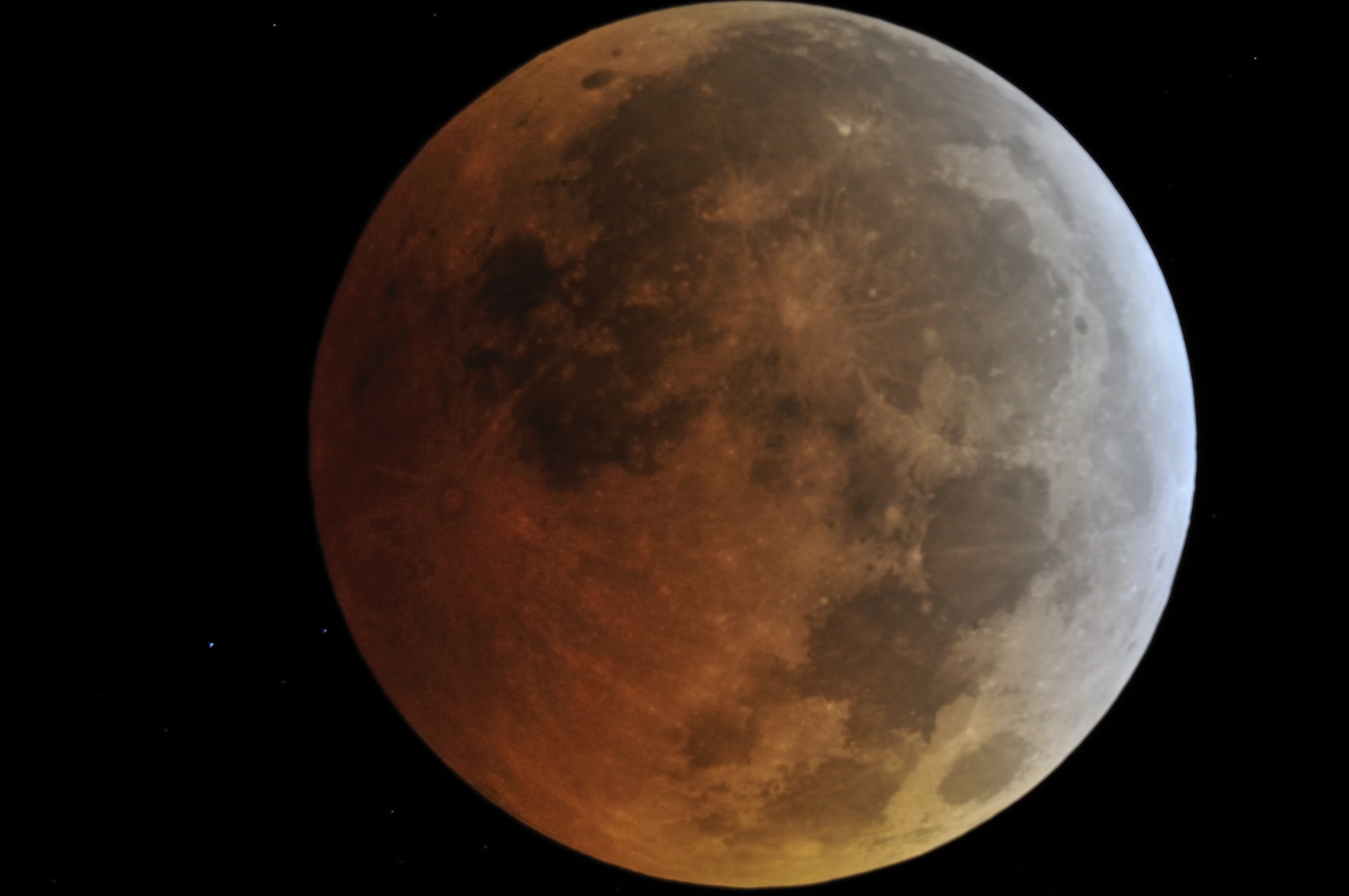 |
||||||||
| 12-27-10 no sunspots Solar wind speed: 342.7 km/sec density: 2.1 protons/cm3 explanation | more data Updated: Today at 1355 UT 6-hr max: B1 1241 UT Dec27 24-hr: B1 1241 UT Dec27 explanation | more data Updated: Today at: 1400 UT |
||||||||
| 12-26-10 no sunspots Solar wind speed: 386.5 km/sec density: 5.1 protons/cm3 explanation | more data Updated: Today at 2344 UT 6-hr max: A6 1857 UT Dec26 24-hr: A6 1857 UT Dec26 explanation | more data Updated: Today at: 2300 UT |
||||||||
| 12-25-10 no sunspots Solar wind speed: 413.3 km/sec density: 7.1 protons/cm3 explanation | more data Updated: Today at 2346 UT 6-hr max: A5 2214 UT Dec25 24-hr: A9 1000 UT Dec25 explanation | more data Updated: Today at: 2300 UT 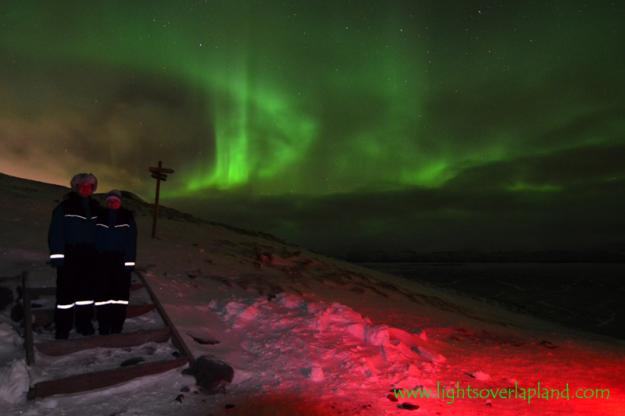 Christmas in Sweden "When I saw the red glow in the snow and the green lights in the sky I could not help but grab the camera and snap a few shots of the Christmas colors," says photographer Chad Blakley of the Aurora Sky Station in Abisko National Park. "It was another great night in Abisko!!" More auroras are in the offing, and this time Santa's assistance will not be required. A solar wind stream flowing from a coronal hole is due to hit Earth's magnetic field on Jan. 2nd. The impact could produce the first geomagnetic storm of the New Year. High-latitude sky watchers should be alert for auroras. |
||||||||
| 12-24-10 no sunspots Solar wind speed: 340.8 km/sec density: 9.3 protons/cm3 explanation | more data Updated: Today at 2344 UT 6-hr max: A4 1824 UT Dec24 24-hr: A7 0012 UT Dec24 explanation | more data Updated: Today at: 2300 UT |
||||||||
| 12-23-10 no sunspots Solar wind speed: 321.6 km/sec density: 5.4 protons/cm3 explanation | more data Updated: Today at 2346 UT 6-hr max: A5 2149 UT Dec23 24-hr: A5 1227 UT Dec23 explanation | more data Updated: Today at: 2300 UT THE PHOTO OF THE LUNAR ECLIPSE IS ABOVE: The combination of blues and reds at the onset of totality was simply beautiful," says Westlake. "I took the picture using a Nikon D700 digital camera with a 11-inch Celestron telescope."The luminosity of the eclipse reveals much about the state of Earth's upper atmosphere. University of Colorado Prof. Richard Keen explains: "At the distance of the Moon, most of the light refracted into Earth's shadow passes through the stratosphere. When the stratosphere is clear (not 'dirtied' by volcanic aerosols) the shadow and therefore the eclipsed Moon is relatively bright." Keen observed the eclipse on Dec. 21st and was able to draw some conclusions. "Using an 8x reversed monocular, I estimated the visual magnitude of the eclipsed moon at mid-totality as -1.9. This compares with a 'clear stratosphere' value of -2.1 to give a volcanic aerosol optical depth of 0.004--essentially zero. The stratosphere remains clear." This is timely and important because the state of the stratosphere affects climate; a clear stratosphere "lets the sunshine in" to warm the Earth below. Yesterday's bright eclipse reinforces a conclusion Keen reported at the SORCE conference in 2008: "The lunar eclipse record indicates a clear stratosphere over the past decade, and that this has contributed about 0.2 degrees to recent warming."UPDATED:
Lunar Eclipse Photo Gallery |
||||||||
| 12-22-10 no sunspots Solar wind speed: 299.1 km/sec density: 1.9 protons/cm3 explanation | more data Updated: Today at 2346 UT 6-hr max: A4 2119 UT Dec22 24-hr: A4 2119 UT Dec22 explanation | more data Updated: Today at: 2300 UT |
||||||||
12-21-10 no sunspotsFirst Winter Solstice With Lunar Eclipse In 456 YearsPosted on: Saturday, 18 December 2010, 15:55 CST
The winter solstice is the shortest day of the year, and it has not fallen on the same day as a lunar eclipse since 1554, according to NASA. This eclipse will be the second on two eclipses in 2010. The first was a partial lunar eclipse that took place on June 26, 2010. Some believe that this event holds special significance, such as one ancient culture who saw the winter solstice as a time of renewal. The winter solstice played an important role in the Greco-Roman rituals "If (the eclipse) happened on the 21st, they might well have been drunk," he said. However, skeptics say that it is just an event with not significance. "It's quite rare, but there's no profound significance. It's luck of the draw; you got dealt four aces," said Robert Dick, an astronomy instructor at Carleton. The eclipse will be completely visible for North and South America just after midnight Eastern Time on Tuesday, lasting until about 5:30 a.m. for North and South America. Europe will be able to catch a glimpse of the beginning of the lunar eclipse, but Japan will be catching the ending. This lunar eclipse is part of the Saros cycle, which is an eclipse cycle with a period of 18 years and a little over 11 days. This cycle is useful for predicting the times of when nearly identical eclipses will occur. Solar wind speed: 347.6 km/sec density: 1.2 protons/cm3 explanation | more data Updated: Today at 1741 UT 6-hr max: A4 1109 UT Dec21 24-hr: A5 0615 UT Dec21 explanation | more data Updated: Today at: 1700 UT TOTAL LUNAR ECLIPSE: Earlier today, for the first time in 372 years, a total lunar eclipse occurred on the date of the northern winter solstice. Observers in North America were favored with an overhead view as the full Moon slipped in and out of Earth's eerie red shadow. Jonathan Sabin sends this picture from Ellenton, Florida:
"It was an absolutely gorgeous night for an eclipse!" says Sabin. Sabin's photo captured not only the red light at the core of Earth's shadow caused by sunlight filtering through the stratosphere, but also the "turquoise fringe" caused by our planet's ozone layer. Pictures like this are golden for researchers who look at the colors of eclipses to diagnose the state of Earth's atmosphere. See "All-Clear in the Stratosphere," below. New: Lunar Eclipse Photo Gallery more images: from Rod Lindley of Dallas, TX; from Kevin R. Witman of Cochranville, Pennsylvania; from John W. O'Neal, II of Amherst, Ohio; from Evan Ludes of Omaha, Nebraska; from John Stetson of Southport, CT; from Mark A. Brown of Carlisle, Pennsylvania; from Giancarlo Ubaldo Nappi of Belo Horizonte MG, Brazil; from Phil Harrington of Long Island, NY; from Mike Mezeul II of Sachse, Texas |
||||||||
| 12-20-10 no sunspots Solar wind speed: 425.2 km/sec density: 5.2 protons/cm3 explanation | more data Updated: Today at 2344 UT
6-hr max: A5 1855 UT Dec20 24-hr: A9 1138 UT Dec20 explanation | more data Updated: Today at: 2300 UT RARE LUNAR ECLIPSE: The lunar eclipse of Dec. 21st falls on the same date as the northern winter solstice. Is this rare? It is indeed, according to Geoff Chester of the US Naval Observatory, who inspected a list of eclipses going back 2000 years. "Since Year 1, I can only find one previous instance of an eclipse matching the same calendar date as the solstice, and that is Dec. 21, 1638," says Chester. "Fortunately we won't have to wait 372 years for the next one...that will be on Dec. 21, 2094." |
||||||||
| 12-19-10 no sunspots Solar wind speed: 399.0 km/sec density: 10.2 protons/cm3 explanation | more data Updated: Today at 2305 UT 6-hr max: A6 2049 UT Dec19 24-hr: B1 0455 UT Dec19 explanation | more data Updated: Today at: 2300 UT |
||||||||
| 12-18-10 sunspot 1133 Solar wind speed: 381.4 km/sec density: 2.6 protons/cm3 explanation | more data Updated: Today at 2344 UT 6-hr max: A6 1826 UT Dec18 24-hr: B1 0001 UT Dec18 explanation | more data Updated: Today at: 2300 UT ALL-CLEAR IN THE STRATOSPHERE: Earth's stratosphere is as clear as it's been in more than 50 years. University of Colorado climate scientist Richard Keen knows this because he's been watching lunar eclipses. "Since 1996, lunar eclipses have been bright, which means the stratosphere is relatively clear of volcanic aerosols. This is the longest period with a clear stratosphere since before 1960." Consider the following comparison of a lunar eclipse observed in 1992 after the Philippine volcano Pinatubo spewed millions of tons of gas and ash into the atmosphere vs. an "all-clear" eclipse in 2003:
Keen explains why lunar eclipses can be used to probe the stratosphere: "At the distance of the Moon, most of the light refracted into the umbra (Earth's shadow) passes through the stratosphere, which lies 10 to 30 miles above the ground. When the stratosphere is clear, the umbra (and therefore, the eclipsed Moon) is relatively bright. On the other hand, if the atmospheric lens that illuminates the Moon becomes dirty enough, light will be blocked and the eclipse will appear dark." This is timely and important because the state of the stratosphere affects climate; a clear stratosphere "lets the sunshine in" to warm the Earth below. At a 2008 SORCE conference Keen reported that "The lunar eclipse record indicates a clear stratosphere over the past decade, and that this has contributed about 0.2 degrees to recent warming." What will the eclipse 21st eclipse look like? "The stratosphere is still fairly clear, and the December 2010 eclipse should be normally bright," predicts Keen. "I welcome any and all reports on the brightness of future lunar eclipses for use in my volcano-climate studies. While actual brightness measurements (in magnitudes) made near mid-totality are most useful, I can also make use of Danjon-scale ratings of the ecl ipse. Please be sure to note the time, method, and instruments used in your reports." Submit your observations here.
DRAGON STORM: Saturn's great "Dragon Storm" has returned. The ferocious thunderstorm observed for years by NASA's Cassini spacecraft has recently been hiding under high clouds, but now it is showing itself again. Using an 11-inch Celestron telescope, Christopher Go of the Philippines photographed the white tempest on Dec. 13th:
|
||||||||
12-17-10 sunspot 1133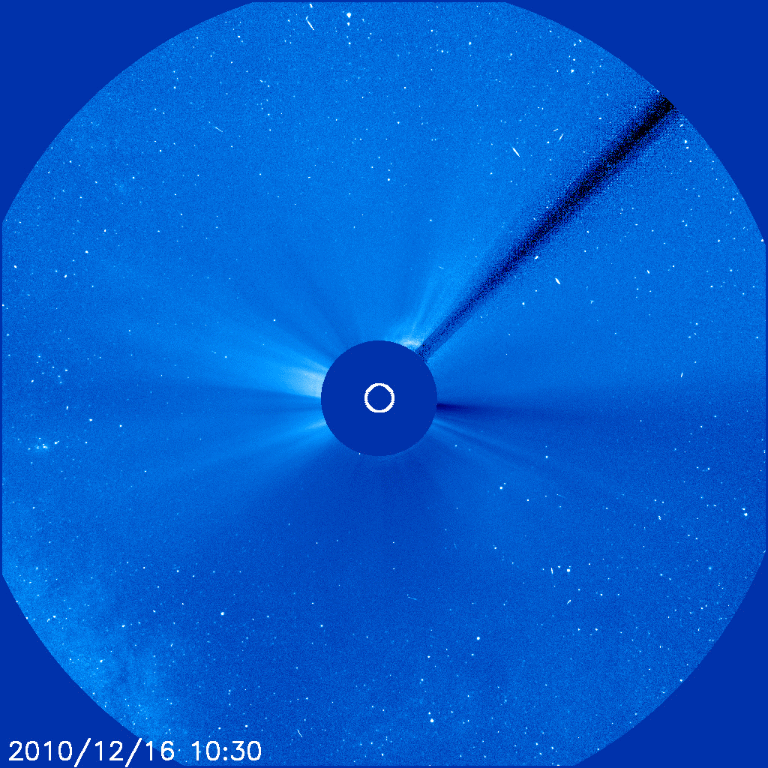
SOLSTICE ECLIPSE: Northern winter is beginning
in a special way. On Dec. 21st, the winter solstice, a lunar eclipse
will be visible across all of North America. Get the
full story from Science@NASA. UPWARD BLAST: Magnetic filaments have been erupting on the sun with uncommon frequency these past two weeks. The latest event occurred On Dec. 16th around 0800 UT when a filament lifted off the stellar surface and propelled a coronal mass ejection into space. Coronagraphs onboard the Solar and Heliospheric Observatory (SOHO) recorded the expanding cloud:
Earth was not in the line of fire; no planets were. The cloud is heading up and away from the plane of the solar system where it will dissipate with little effect a week or two hence. Like all the recent eruptions, this one missed our planet, but it is only a matter of time before a scattershot CME reaches Earth. When it does, you'll want to be alert for auroras. Solar wind speed: 483.5 km/sec density: 4.2 protons/cm3 explanation | more data Updated: Today at 1206 UT 6-hr max: B4 0744 UT Dec17 24-hr: B4 0744 UT Dec17 explanation | more data Updated: Today at: 1200 UT SOLSTICE ECLIPSE: Northern winter is beginning in a special way. On Dec. 21st, the winter solstice, a lunar eclipse will be visible across all of North America. Get the full story from Science@NASA. |
||||||||
| 12-16-10 sunspot 1133 Solar wind speed: 509.8 km/sec density: 1.9 protons/cm3 explanation | more data Updated: Today at 0825 UT 6-hr max: B7 0427 UT Dec16 24-hr: B7 0427 UT Dec16 explanation | more data Updated: Today at: 0800 UT GEO-QUIET: Although a solar wind stream is buffeting Earth's magnetic field, it's a gentle buffeting, and geomagnetic activity is low. Strong auroras are unlikely during the next 24 hours. GREAT GEMINIDS: On Dec. 13th and 14th, Earth passed through a stream of debris sputtering from mystery-rock 3200 Phaethon. The result was the annual Geminid meteor shower. At maximum, international observers counted more than 100 meteors per hour. "Even clouds could not stop the Geminids from putting on a great display," says John Chumack of Dayton, Ohio. "Just watch this movie."
More Geminid highlights from around the world may be found in the gallery: UPDATED:
2010 Geminid Meteor Photo Gallery MAGNETIC ERUPTION : On Dec. 14th around 1530 UT, a filament of magnetism lifted up from the surface of the sun and--snap!--erupted. NASA's Solar Dynamics Observatory recorded the action:
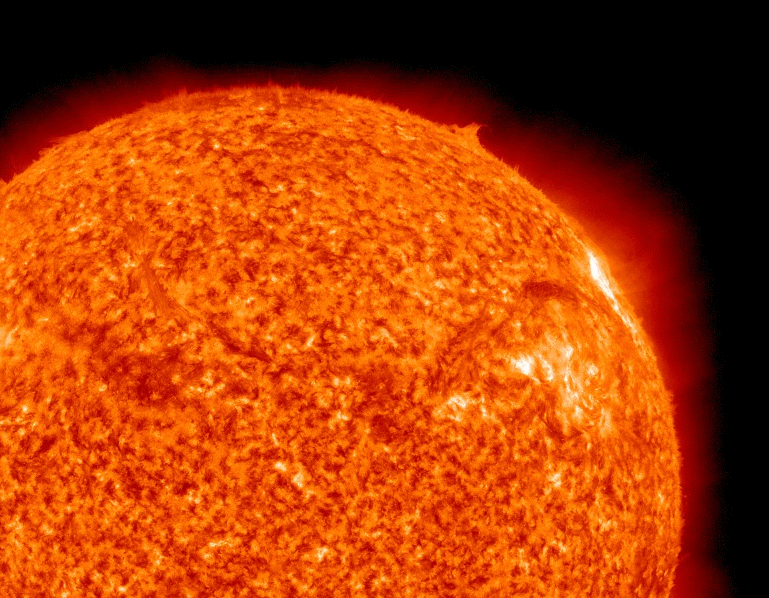 The blast produced an hours-long C2-class solar flare and hurled a magnificent CME into space: SOHO movie. The expanding cloud is not heading directly toward Earth, but it might deliver a glancing blow to our planet's magnetic field two or three days hence. High latitude sky watchers should be alert for auroras.
GLOBAL ERUPTION ROCKS THE SUN: A global eruption on the sun has shattered old ideas about solar activity. Researchers presented their surprising findings at a press conference Monday at the American Geophysical Union meeting in San Francisco. Get the full story from Science@NASA. Dec. 13, 2010: On August 1, 2010, an entire hemisphere of the sun erupted. Filaments of magnetism snapped and exploded, shock waves raced across the stellar surface, billion-ton clouds of hot gas billowed into space. Astronomers knew they had witnessed something big. It was so big, it may have shattered old ideas about solar activity. "The August 1st event really opened our eyes," says Karel Schrijver of Lockheed Martin's Solar and Astrophysics Lab in Palo Alto, CA. "We see that solar storms can be global events, playing out on scales we scarcely imagined before." For the past three months, Schrijver has been working with fellow Lockheed-Martin solar physicist Alan Title to understand what happened during the "Great Eruption." They had plenty of data: The event was recorded in unprecedented detail by NASA's Solar Dynamics Observatory and twin STEREO spacecraft. With several colleagues present to offer commentary, they outlined their findings at a press conference today at the American Geophysical Union meeting in San Francisco. Explosions on the sun are not localized or isolated events, they announced. Instead, solar activity is interconnected by magnetism over breathtaking distances. Solar flares, tsunamis, coronal mass ejections--they can go off all at once, hundreds of thousands of miles apart, in a dizzyingly-complex concert of mayhem.
"To predict eruptions we can no longer focus on the magnetic fields of isolated active regions," says Title, "we have to know the surface magnetic field of practically the entire sun." This revelation increases the work load for space weather forecasters, but it also increases the potential accuracy of their forecasts. "The whole-sun approach could lead to breakthroughs in predicting solar activity," commented Rodney Viereck of NOAA's Space Weather Prediction Center in Boulder, CO. "This in turn would provide improved forecasts to our customers such as electric power grid operators and commercial airlines, who could take action to protect their systems and ensure the safety of passengers and crew." In a paper they prepared for the Journal of Geophysical Research (JGR), Schrijver and Title broke down the Great Eruption into more than a dozen significant shock waves, flares, filament eruptions, and CMEs spanning 180 degrees of solar longitude and 28 hours of time. At first it seemed to be a cacophony of disorder until they plotted the events on a map of the sun's magnetic field. Title describes the Eureka! moment: "We saw that all the events of substantial coronal activity were connected by a wide-ranging system of separatrices, separators, and quasi-separatrix layers." A "separatrix" is a magnetic fault zone where small changes in surrounding plasma currents can set off big electromagnetic storms.
|
||||||||
| 12-15-10 sunspot 1133 Solar wind speed: 588.3 km/sec density: 1.6 protons/cm3 explanation | more data Updated: Today at 2344 UT 6-hr max: B1 2225 UT Dec15 24-hr: C5 0639 UT Dec15 explanation | more data Updated: Today at: 2300 UT
|
||||||||
| 12-14-10 sunspot 1133 Solar wind speed: 601.7 km/sec density: 2.7 protons/cm3 explanation | more data Updated: Today at 2345 UT 6-hr max: C1 1701 UT Dec14 24-hr: C2 1554 UT Dec14 explanation | more data Updated: Today at: 2300 UT The blast produced an hours-long C2-class solar flare and hurled a magnificent CME into space: SOHO movie. The expanding cloud is not heading directly toward Earth, but it might deliver a glancing blow to our planet's magnetic field two or three days hence. Stay tuned for a more refined analysis later today. |
||||||||
| 12-13-10 sunspot 1131, 1133 Solar wind speed: 493.9 km/sec density: 2.9 protons/cm3 explanation | more data Updated: Today at 1656 UT 6-hr max: B2 1330 UT Dec13 24-hr: B2 1330 UT Dec13 explanation | more data Updated: Today at: 1700 UT SPIRAL ASTEROID: On Dec. 12th, the International Astronomical Union issued a telegram (CBET nr.2583) announcing the discovery of a spiral structure around main belt asteroid (596) Scheila. Steve Larson of the Catalina Sky Survey (CSS) found the curious shape in images obtained Dec. 11th through the Catalina 0.68-m Schmidt telescope. Other observers have since confirmed the phenomenon. The following picture was taken on Dec. 12th by Italian astronomers Ernesto Guido and Giovanni Sostero using a remotely-controlled 0.25m telescope in New Mexico:
What's going on? There are at least two possibilities. (1) A small asteroid might have hit 596 Scheila, raising a cloud of dust which forms a nebula around the larger space rock. A 1-meter class impactor would be large enough to do the trick. (2) 596 Scheila might be a rare main belt comet, a body with the orbital characteristics of an asteroid and the physical characteristics of a comet. If so, a pocket of volatile ice might be vaporizing to produce the spiraling tail. How the tail evolves in the days ahead could provide important clues. Amateur astronomers with experience in asteroid imaging are encouraged to monitor developments. [3D orbit] [ephemeris (enter "Scheila" in the search box)] more images: from Joseph Brimacombe using a remotely-controlled telescope in New Mexico; from Charles Bell of Vicksburg, Mississippi; TRIPLE ERUPTION: Solar activity surged on Sunday, Dec. 12th, when the sun erupted three times in quick succession, hurling a trio of bright coronal mass ejections (CMEs) into space. Coronagraphs onboard the Solar and Heliospheric Observatory recorded the action:
A preliminary analysis suggests that none of the CMEs will be geoeffective. The expanding clouds should miss our planet. Are these CMEs related? According to images from NASA's twin STEREO
spacecraft and the Solar Dynamics Observatory, the clouds emerged from
three distinct blast sites separated by great distances. In each case, a
magnetic filament erupted--one near the sun's southeastern limb (CME#1),
one near the north pole (CME#2), and one on the far side of the sun
(CME#3). Because all three eruptions occurred within a matter of hours,
the coronagraph images suggest a single 3-lobed cloud; in fact, they are
distinct CMEs. |
||||||||
| 12-12-10 sunspots
1131 and 1133 Solar wind speed: 311.3 km/sec density: 2.0 protons/cm3 explanation | more data Updated: Today at 1136 UT
6-hr max: B4 0749 UT Dec12 24-hr: B4 0749 UT Dec12 explanation | more data Updated: Today at: 1100 UT GEMINID METEOR UPDATE: Go outside at midnight and stare at the sky for six minutes. Right now, that's about how long it takes to see a Geminid meteor, according to counts posted by the International Meteor Organization. The pace will pick up in the nights ahead as Earth plunges deeper into the Geminid debris stream. On peak night, Dec. 13th-14th, meteor rates could jump as high as 120 per hour, reducing the wait from six minutes to a mere 30 seconds.BUSY ICE HALO: In Stockholm, Sweden, the sun was only up for a little while Wednesday, but it made good use of its time. Sunbeams lanced through ice crystals in the air, producing a busy halo of surpassing beauty:
"This was the most spectacular sun halo I have seen in recent years from Stockholm," says photographer Peter Rosén. "It was visible for the whole (short) day." In addition to the sundogs, upper tangent arc, and 22° halo captured in the snapshot above, Rosén also witnessed "a 46° outer halo and a circumzenithal arc as ice crystals blew in gusts across the sun. What a show!" Now is the time of year when low-hanging suns shine through high-floating ice to produce such vistas. People of the northern hemisphere should be alert for halos. more images:
from Jörgen Blom of Stockholm, Sweden;
from Merelyn Davis of Burbank, CA;
from Paul Ballard of Kungälv, Sweden;
from Gary Brekke of Fargo, ND;
from Shawn Johnston of Fargo, ND;
from Joanna Fengler of Poznan, Poland |
||||||||
| `12-11-10
Solar wind speed: 311.6 km/sec density: 1.1 protons/cm3 explanation | more data Updated: Today at 2257 UT
6-hr max: B2 1749 UT Dec11 24-hr: B4 1117 UT Dec11 explanation | more data Updated: Today at: 2300 UT |
||||||||
| 12-10-19 Solar wind speed: 358.6 km/sec density: 0.8 protons/cm3 explanation | more data Updated: Today at 2346 UT
6-hr max: B2 1912 UT Dec10 24-hr: B2 1912 UT Dec10 explanation | more data Updated: Today at: 2300 UT |
||||||||
| 12-09=10 Solar wind speed: 326.8 km/sec density: 1.0 protons/cm3 explanation | more data Updated: Today at 2346 UT
6-hr max: B1 1833 UT Dec09 24-hr: B1 0320 UT Dec09 explanation | more data Updated: Today at: 2300 UT |
||||||||
12-08-10 sunspot 1131 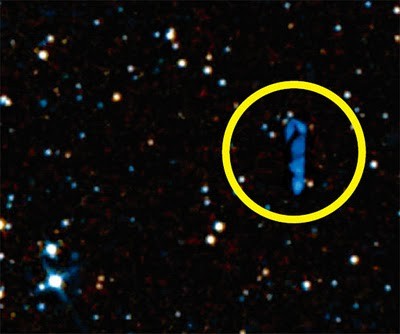 three objects in space heading oyr way Solar wind speed: 382.5 km/sec density: 3.0 protons/cm3 explanation | more data Updated: Today at 2345 UT
6-hr max: B1 1821 UT Dec08 24-hr: B2 1139 UT Dec08 explanation | more data Updated: Today at: 2300 UT NORTHERN LIGHTS: Last night (Dec. 7th) a minor gust of solar wind gently buffeted Earth's magnetic field. At the Aurora Sky Station in Sweden, above the Arctic Circle, a gentle gust is all it takes to ignite auroras you can reach out and touch ... almost: "Every night our staff checks spaceweather.com to see what the future may hold," says Sky Station photographer Chad Blakley. "Needless to say, we were all excited when we saw the density of the solar wind rise above 15 protons/cm3. Soon the auroras began, and they did not stop until we all went home six hours later." (For the record, the auroras pictured above were more than 100 km above Blakeley's head.) A more forceful gust of solar wind is en route to Earth, due to arrive on Dec. 10th. High-latitude sky watchers should remain alert for auroras. more images: from Marketa Stanczykova of Iceland, Reykjavik; from Borkur Hrolfsson of Þingvellir, Iceland; from Frank Olsen outside Tromsø, Norway; from Fredrik Broms of Kvaløya, Norway; from Börkur Hrólfsson of Reykjavik, Iceland; from Øystein Lunde Ingvaldsen of Bø in Vesterålen, Norway; from Kjetil Skogli outside Tromsø, Norway; |
||||||||
12-07-10 sunspot
1131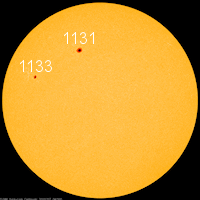 You can see the sunspot near the upper center Solar wind speed: 365.6 km/sec density: 3.5 protons/cm3 explanation | more data Updated: Today at 2345 UT MARS POPS OUT: Last night (Dec. 6th), deep in western twilight, the crescent Moon eclipsed (occulted) Mars over North America. "I was perfectly placed to observe the event," says Doug Zubenel of De Soto, Kansas, who caught Mars popping out from behind the crescent. "It happened right behind the water tower of De Soto!" 6-hr max: B1 2020 UT Dec07 24-hr: B2 0022 UT Dec07 explanation | more data Updated: Today at: 2300 UT
|
||||||||
12-6-10 sunspot 1131 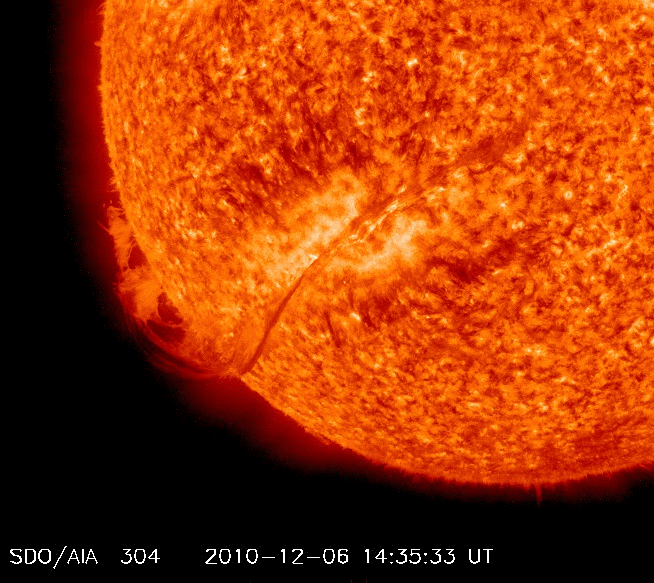 EPIC BLAST: As predicted, the a "mega-filament" of solar magnetism erupted on Dec. 6th, producing a blast of epic proportions. NASA's Solar Dynamics Observatory recorded the action as the 700,000-km long structure lifted off the stellar surface and--snap!!--hurled itself into space. Click on the arrow to play the movie: movie formats: 4 MB gif, 1 MB iPad, 0.5 MB iPhone, 1 MB still frame The eruption produced a bright coronal mass ejection (CME) observed by the STEREO-A spacecraft: video. Earth was not in the line of fire; the cloud should sail wide of our planet. Earth-effects might be limited to pretty pictures. more images: from Stephen W. Ramsden of Atlanta, GA Solar wind speed: 284.5 km/sec density: 5.8 protons/cm3 explanation | more data Updated: Today at 0305 UT
6-hr max: B1 1954 UT Dec05 24-hr: B4 0530 UT Dec05 explanation | more data GREEN SNOW: Globally, Earth's magnetic field has been quiet this weekend, but in one corner of northern Canada the story was different. "Last night," reportsFrancis Anderson, "the auroras here in Tuktoyaktuk of the Northwest Territories were so bright they cast shadows on the ground and [turned the snow green]!" The phenomenon is called a "substorm" and it gives reason for people of the North to keep an eye on the sky even when the global forecast calls for quiet--like now.
RADIO STORM ON JUPITER: Astronomers have long known that Jupiter is a source of powerful shortwave radio bursts. "Last Sunday afternoon (Nov. 28) I received an alert from radio astronomer Wes Greenman in Florida that Jupiter was storming strongly," reports Thomas Ashcraft of New Mexico. "Although it was 4 pm and the sun was still up, I swung my radio antenna towards Jupiter and tuned right into a crashing storm." Click on the image below to hear the alien sounds that emerged from the loudspeaker of Ashcraft's 21 MHz radio telescope:Radio signals from Jupiter are not a sign of extraterrestrial intelligence. They occur naturally, caused by plasma instabilities in Jupiter's magnetosphere and fueled by powerful electric currents that flow between Jupiter and the volcanic moon Io. These radio bursts are so powerful, they can be picked up with simple antennas and receivers. Indeed, shortwave listeners often detect Jupiter by accident and don't even realize the origin of the crashing sounds they are hearing. Readers, would you like to tune into Jupiter using your own radio telescope? Check out NASA's RadioJOVE program for instructions.
12-5-10 aunspots 1132 and 1133 Solar wind speed: 276.9 km/sec density: 4.0 protons/cm3 explanation | more data Updated: Today at 2345 UT
6-hr max: B1 1954 UT Dec05 24-hr: B4 0530 UT Dec05 explanation | more data Updated: Today at: 2300 UT
GREEN SNOW: Globally, Earth's magnetic field has
been quiet this weekend, but in one corner of northern Canada the story
was different. "Last night," reports |
||||||||
| 12-4-10 sunspot 1130 and 1131 MAGNETIC FILAMENT: A magnetic filament more than 400,000 km long is snaking around the sun's southeastern limb. NASA's Solar Dynamics Observatory photographed it rotating into view during the early hours of Dec. 3rd:
This comes as no surprise. NASA's STEREO-B spacecraft has been monitoring the filament for days as it approached the sun's horizon from behind. So far the massive structure has hovered quietly above the stellar surface, showing no signs of instability. How long can the quiet last? Long filaments like this one have been known to collapse with explosive results when they hit the star below. Stay tuned for developments. |
||||||||
| 12-3-10 sunspot 1130 Solar wind speed: 286.4 km/sec density: 6.2 protons/cm3 explanation | more data Updated: Today at 2347 UT
6-hr max: B2 2015 UT Dec03 24-hr: B5 0658 UT Dec03 explanation | more data Updated: Today at: 2300 UT ARSENIC-BUG" RE-DEFINES LIFE: Biology textbooks beware. A microbe in California's Mono Lake is challenging long-held ideas about the basic chemistry of life. The GFAJ-1 strain of Gammaproteobacteria uses toxic arsenic as a key building block of its DNA, causing astrobiologists to re-think the possibilities for life on and off our planet. Get the full story from Science@NASA. |
||||||||
| 12-2-10 sunspot 1130 Solar wind speed: 310.3 km/sec density: 0.6 protons/cm3 explanation | more data Updated: Today at 2345 UT
6-hr max: B2 2228 UT Dec02 24-hr: B2 1308 UT Dec02 explanation | more data Updated: Today at: 2300 UT NEW
SUNSPOT: A sunspot is emerging
over the sun's northeastern limb, and it appears to be one of the
largest of the new solar cycle. This composite image from NASA's Solar
Dynamics Observatory shows the sunspot's dark core (inset) and plumes of
plasma shooting up from the active region: I t is too soon to say whether this sunspot poses a threat for strong solar flares. At the moment we are seeing the region almost edge-on, so the sunspot's magnetic field (the source of flares) is not fully available for inspection. One thing is certain: It's photogenic. Readers with backyard solar telescopes are encouraged to monitoor developments.more images:
from Peter Paice of Belfast, Northern Ireland |
||||||||
| 12-1-10 - sunspots Solar wind speed: 327.7 km/sec density: 0.5 protons/cm3 explanation | more data Updated: Today at 2345 UT
6-hr max: B6 1845 UT Dec01 24-hr: C1 0622 UT Dec01 explanation | more data Updated: Today at: 2300 UT
POSSIBLE EARTH-DIRECTED ERUPTION: A magnetic filament in the sun's northeastern quadrant erupted during the late hours of Nov. 30th. Click on the image to play a movie recorded by NASA's Solar Dynamics Observatory--and pay attention to the bright splash below the movie arrow: The blast produced a B-class solar flare and hurled a bright coronal mass ejection (CME) into space. Preliminary coronagraph images from NASA's twin STEREO spacecraft suggest that the cloud might be heading toward Earth. Further analysis is required, however, to confirm that the CME is coming our way.
|